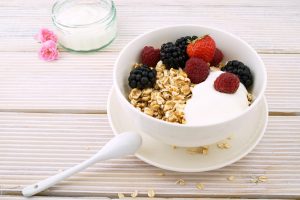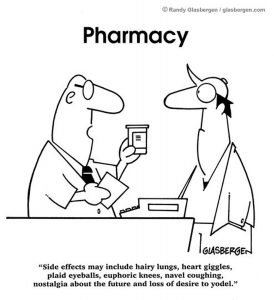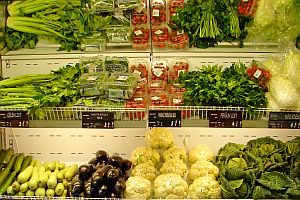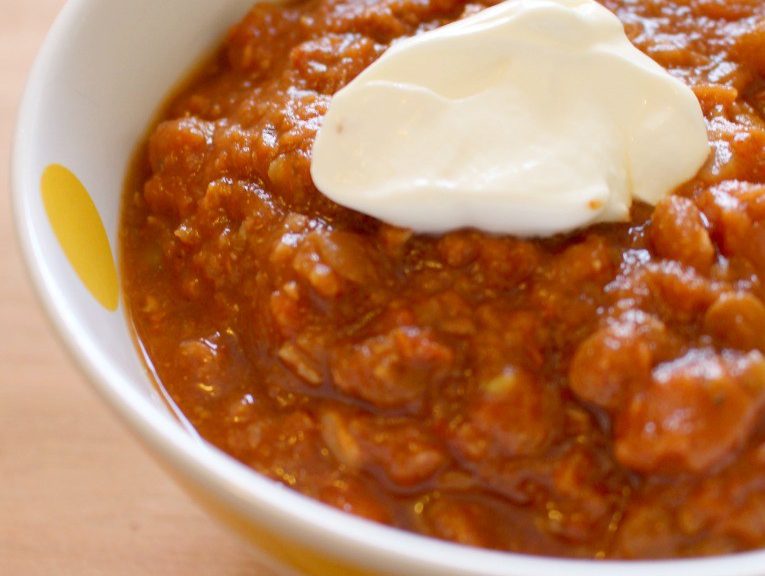[amd-zlrecipe-recipe:12]
Almond-Honey Power Bar
[amd-zlrecipe-recipe:10]
Crock Pot Madras Lentils
This is such a fun recipe discovery! We got a sample of this dish at Costco…it is a yummy substitute for mild chili (you could spice it up) and a fun convenience food the way it is sold at Costco but here’s an easy recipe for a quick, inexpensive and delish go to meal for a busy night!
[amd-zlrecipe-recipe:8]
Top Foods for a Healthy Nervous System
The health of your nervous system is vital for maintaining all your body’s functions and avoiding a range of potentially serious health problems. But if you’re not getting a sufficient amount of the nutrients needed for good nervous system health, you can experience such as numbness, nervous twitches or even muscle cramps. Fortunately, one of the easiest things you can do to help ensure a healthy nervous system is to eat the right kinds of foods.
Here’s a quick overview of several nutrients that play a key role in keeping your nervous system healthy and working the way it should.
Vitamin B1 (thiamin)
A deficiency of this vitamin can give you that pins-and-needles sensation in the toes or burning feet, especially at night. Good foods for vitamin B1 are beef liver, seafood, brewer’s yeast, beans, eggs and sunflower seeds.
Vitamin B6
Nerve cell communication suffers without this vitamin. Two key neurotransmitters, dopamine and serotonin, depend on vitamin B6 for their production. Bananas, potatoes, and chick peas are good sources.
Vitamin B12
A shortage of this vitamin can result in tingling and numbness in the hands and feet. Clams, fish, eggs, meat and dairy products are key sources of vitamin B12.
Copper
Like vitamin B6, this mineral is essential for the production of neurotransmitters. A severe lack of copper in your diet can lead to spinal cord degeneration and a progressive failure of nerve function. Liver and oysters are the best sources. Add prunes, spinach and kale (as well as other dark, leafy green vegetables), and nuts to your diet for even more copper.
Healthy foods for good nervous system function include the following:
Spinach—In addition to containing a powerhouse stock of nutrients and vitamins, this leafy green vegetable also contains an abundance of antioxidants to boost overall health and slow down the aging of the brain and nervous system.
Whole grains—Brown rice in particular contains high levels of vitamin B6, which helps to protect against mental deterioration caused by high levels of harmful homocysteines. Whole grains also include magnesium, which is important for the health of your nervous system. Stabilized rice bran contains one of the highest levels of antioxidants of all known foods.
Cocoa—This contains a powerful antioxidant that puts the brakes on oxidative stress that can lead to Alzheimer’s and similar neurological ailments. It is also high in magnesium.
Whey—An excellent food for a naturally calming effect. Rich in L-tryptophan, which the body cannot produce, this essential amino acid is vital in the production of serotonin, an essential neurotransmitter. Low levels of serotonin can lead to depression.
Garlic—This not only includes antioxidants, but garlic can help prevent aging of the brain and prevent infections, too.
So try working more of the above foods into your weekly menus, and feel pleased that you are doing something good for the health of your nervous system!
If feel that you need help with improving your eating habits and diet, we are just a phone call away! You can call at Oblander Chiropractic at 406-652-3553. Dr. Oblander is always willing to meet with you to discuss your nutritional needs!
Top 5 Ways to Improve Your Digestion
A well-functioning digestive system is crucial to maintaining your body’s overall health. Without it, you are likely to have bowel problems and suffer from digestive upsets, not to mention a host of other conditions that can result from not getting enough nutrients from the food you eat. The digestive system affects all the other systems of the body, so it’s important to do what you can to be sure it’s working the way it should. Following are the top 5 things you can do to help improve your digestion.
Eat more fiber – Soluble and insoluble fiber are both essential for moving food through the digestive tract. Soluble fiber, such as that found in oatmeal, beans, nuts and apples, turns to a gel in your intestines and slows digestion, helping to maintain stable blood sugar levels. It absorbs water, softening the stool, and promotes the health of the good bacteria in your gut. Insoluble fiber, such as that found in the skins of fruit and vegetables, speeds digestion, adds bulk and passes primarily intact through the digestive tract. Both are important in preventing constipation and can improve conditions such as irritable bowel syndrome (IBS).
Drink more fluids – Insufficient water intake can harden the stool, increasing constipation. You should be sure to drink at least 1.2 liters of fluid per day, which is about 6 glasses. Some people need more, based on their activity level and the ambient temperature. However, do not drink more than about 6 ounces of liquid during a meal (taking the occasional sip), as it can dilute your stomach acid, making digestion more difficult. Aim to get most of your fluid intake 15-30 minutes before a meal or at least an hour afterward.
Take probiotics – Probiotics such as Lactobacillus and Bifidobacteria are the good bacteria that populate our digestive tract. Eating yogurt with a variety of helpful live cultures as well as fermented foods like sauerkraut, kombucha and kefir can help promote the production and health of these beneficial bacteria.
Eat more fat – Although increasing your fiber intake can improve your digestion that fiber does not move through the digestive tract so easily if you are not getting enough fat in your diet. Good fats will not raise your cholesterol and in fact are a healthy part of your diet when eaten in moderation. Some healthy sources of fat are olive oil, coconut oil, butter and avocados.
Reduce stress – When you are under stress, your digestive system slows down and circulation to the digestive tract is reduced, lowering your body’s ability to efficiently break down and utilize the food you eat. Do not rush through meals, and be sure to sufficiently chew and savor your food when you eat. If you must eat while under stress, be sure you eat foods that are simple to digest, such as broth or yogurt.
6 Reasons to Stop Buying Microwave Popcorn
6 Reasons to Stop Buying Microwave Popcorn

Ah, popcorn. A movie staple, a campfire favorite, even a Christmas decoration. We’re big fans of the stuff here at our house. The way we enjoy it, though, is the semi-old fashioned way: we make ours with the air popper (the truly old-fashioned way is in a skillet, over a fire, just in case you were wondering). Back in our pre-microwave days in the 1980s, my mom always made popcorn with the air popper. She’d salt it a little and mix in some melted butter. Mmmmm…
Then the microwave relegated the air popper to the back of the cupboards, taking up space alongside the other hardly used appliances. It just seemed so much more convenient to just pop the bag in the microwave. Sure, sometimes a good portion of the bag’s contents were either charred or completely unpopped, but that was the trade-off for a pre-seasoned and effortless bag of popcorn. That’s the way it was for us, at least.
For Christmas in 2008, my parents gave us an air popper (we’re still using the same one) and some fun serving containers. We stopped buying the microwave stuff and have only used our air popper ever since. Though this is our preferred way to pop, there are other methods, like cooking it on the stovetop or microwaving popcorn kernels in a brown paper bag. Each way works well and is better than the stuff sold pre-packaged at the store. Here are six reasons why you should take the boxes of microwave popcorn off your shopping list…
1. Homemade popcorn is frugal.
Hence the mention on here, right? There is no denying that buying the popcorn kernels is much cheaper, especially if you can find it in the bulk food bins at the grocery store (most common in health/natural food stores). With microwave popcorn, you’re paying for the bags, the brand, the oils and seasonings, and plastic packaging. For the same price of a few bags of microwave popcorn, you could get pounds of the kernels. It only takes a half cup of kernels in our air popper to yield a big bowl of popcorn. A pound of popcorn goes a long way. Even if you buy the popper (which run around $15-25), it’s still the more frugal way to enjoy popcorn. Just by skipping microwave popcorn and getting the kernels in bulk, the popper soon pays for itself in savings.
2. Homemade popcorn is less wasteful.
Whenever I make popcorn, there’s maybe two or three kernels left unpopped, maximum. And I’ve never had burned popcorn making it with the air popper. All those burnt/unpopped kernels at the bottom of the microwave is waste. Unless you’ve gotten microwaving popcorn down to a science or the popcorn setting on your microwave actually works, waste is practically inevitable.
3. Microwave popcorn takes as long to pop as homemade.
To prove this, I timed how long it took to pop half a cup of kernels (which equals a big bowl of popcorn). Barely over two minutes (plus the 30 or so seconds it took to get the popper out of the pantry, get a bowl out of the cupboard, and plug it in). That’s just about as long as it takes to do the microwave stuff. I can’t say how long it takes to do it the other ways I mentioned — on the stovetop or in the paper bag — but I’m willing to bet it’s pretty close. So, really, what are you paying for with microwave popcorn? Is it really that much more convenient?
4. Microwave popcorn is unhealthy. Like, really unhealthy.
I recently read an article entitled, “7 Seven Foods That Should Never Cross Your Lips” and microwave popcorn is on the list. Here’s why, quoting the article:
“Chemicals, including perfluorooctanoic acid (PFOA), in the lining of the bag, are part of a class of compounds that may be linked to infertility in humans, according to a recent study from UCLA. In animal testing, the chemicals cause liver, testicular, and pancreatic cancer. Studies show that microwaving causes the chemicals to vaporize—and migrate into your popcorn. ‘They stay in your body for years and accumulate there,’ says Dr. Naidenko, which is why researchers worry that levels in humans could approach the amounts causing cancers in laboratory animals. DuPont and other manufacturers have promised to phase out PFOA by 2015 under a voluntary EPA plan, but millions of bags of popcorn will be sold between now and then.”
Yuck.
5. Cheap entertainment.
My older son has been entertained by the popcorn popper since the first time we used it, back when was barely two years old. Even now as a big five-year-old, he still likes watching the kernels spin and then pop like crazy. It’s a great way to dispell a grouchy mood. Even though the baby doesn’t eat popcorn yet (choking hazard and all), he giggles and squeals as we make it. Homemade popcorn is also better for crafts like popcorn chains (can you imagine stringing greasy microwave popcorn?).
6. Homemade popcorn tastes better.
Microwave popcorn in “butter flavor” doesn’t come close to popcorn with real butter. It just doesn’t. It might take you a little adjustment at first if you’re used to the intensely flavored and super-salty stuff, but once you’re used to the wholesome taste of popcorn seasoned with some salt and real butter, you’ll think the microwave stuff is gross. Plus, there are other options for seasoning air popped popcorn: cocoa popcorn (my son literally licked the bowl clean), basil popcorn (yum), toffee popcorn (this recipe looks amazing), and more. The best part about homemade popcorn is that you control what goes (and doesn’t go) in it. You can make it as healthy or as decadent as you want.
All this is making me hungry. I’m going to go make some now. So should you.
Here’s a Great Recipe to Warm Us All Up!
[amd-zlrecipe-recipe:3]
Today’s Rice Pudding Recipe was shared from the following website: https://sweetleaf.com/stevia-recipes/sugar-free-cinnamon-vanilla-rice-pudding/
Superfoods: Science or Marketing?
 There is no medical definition for a “superfood”. Food manufacturers are eager to use the word to promote sales of their products that contain traces of supposed superfoods such as blueberries, pomegranates and chocolate. The Oxford English Dictionary defines a superfood as “a nutrient-rich food considered to be especially beneficial for health and well-being.” However, there are no set criteria about what makes a food nutrient-rich. Most superfoods are high in antioxidants and phytonutrients relative to other foods. However, if you were to eat only one of these superfoods to the exclusion of all else, you would be seriously deficient in many of the nutrients your body needs in order to stay healthy. So what exactly is the science behind the idea of superfoods?
There is no medical definition for a “superfood”. Food manufacturers are eager to use the word to promote sales of their products that contain traces of supposed superfoods such as blueberries, pomegranates and chocolate. The Oxford English Dictionary defines a superfood as “a nutrient-rich food considered to be especially beneficial for health and well-being.” However, there are no set criteria about what makes a food nutrient-rich. Most superfoods are high in antioxidants and phytonutrients relative to other foods. However, if you were to eat only one of these superfoods to the exclusion of all else, you would be seriously deficient in many of the nutrients your body needs in order to stay healthy. So what exactly is the science behind the idea of superfoods?
While we would like to believe that if we eat certain foods we can stave off illness and keep aging at bay, the truth is that it’s not so easy. Although there is no doubt that a diet consisting primarily of fruits and vegetables is one of the keys to healthy longevity, it is also what you don’t eat and do that is important. For instance, if you eat a breakfast of blueberries and pomegranates in a bowl of oatmeal, along with a cup of green tea, that does not mean that your health will improve overall if for lunch you have a bucket of fried chicken, French fries and a 64-ounce Coke, followed by a cigarette.
The majority of scientific studies indicating that there may be some positive health effects associated with the nutrients contained in certain foods were conducted in a laboratory. In general, high levels of nutrients are used in these studies—usually far more than what can be consumed in a normal diet. For instance, the compound resveratrol that studies have shown to be heart-healthy and to guard against prostate cancer is found in grape skins only in very small amounts. So although “the French paradox” (why the French have low rates of heart disease despite a rich diet) is often partially attributed to the regular consumption of red wine, in fact, you would have to drink 40 liters of wine a day to get the same amount that was shown to benefit the health of mice in these studies.
The positive results of studies performed in test tubes on a few human cells and studies performed on mice do not necessarily translate into health benefits for the wider population. The effect of a single nutrient on human health is difficult to pinpoint, as we all eat a combination of foods. Some nutritional benefits may only occur in the presence of other nutrients in the same food, or even in a different food eaten at the same time. Iron absorption, for example, is boosted when a food rich in vitamin C is eaten at the same time.
The best nutritional advice someone can follow if they’re interested in maintaining good health is to eat a wide range of whole foods, and (even more importantly) to avoid foods that are bad for you such as processed foods and hydrogenated oils. As the European Food Information Council advises, “A diet based on a variety of nutritious foods, including plenty of fruits and vegetables, remains the best way to ensure a balanced nutrient intake for optimal health.”
The Side Effects from Drugs/Pharmaceuticals is NOT Funny Business

We know that many people feel that it is easier to take a pill than to take care of themselves. It may seem easier in the short term but in the long run, it is never the solution for maximizing your health and longevity. It is now estimated that 95% of all cancers are life-style related. Other health such as heart disease. diabetes, and arthritis are most often related to a person’s lifestyle as well. If you want to be healthy and to age gracefully, the best way is to start improving your lifestyle choices today! If you have any questions on how you might do that, be sure to contact our office!
Today, we are sharing a great article from the Sparman Clinic Blog!:
THE NEGATIVE SIDE-EFFECTS OF PRESCRIPTION MEDICATION
Many side-effects associated with prescription medication can be more detrimental than the condition they are treating. The best way to avoid having to take prescription medication is to take care of yourself through diet, exercise, and natural preventative supplements.
Why the Push For Prescription Medication?:
The pharmaceutical industry is a booming business. Americans spend over $200 billion per year on prescription medication. While many of these medications have helped people recover and live healthy lives, there is a potentially dangerous situation that can result from over-medication (taking an excessive amount of prescription drugs) or using drugs that come with a high-risk of hazardous side-effects. These side-effects can be overlooked when it is seen as a solution to a painful or life-threatening health condition.
What are Some Potential Side-Effects?:
Depending on the type of medication you are choosing, many may only mask or slow the symptoms of a condition, rather than heal. In the process, some negative side-effects can emerge, causing discomfort or health risks. Depending on other medications or a person’s physical make-up, there can be different reactions with different people.
How Can You Reduce Your Risks?:
The best way to reduce your risk of negative side-effects with prescription medication is not taking any! While there are some conditions where this is not an option, many health conditions and diseases can be prevented through diet, exercise, and the use of natural supplements. Preventative care is essential to a long and healthy life free from reliance on prescription medication. Make sure your diet is full of raw, organic fruits and vegetables that provide the essential vitamins and minerals needed for healthy body functions. Exercise should be a regular part of your routine; this keeps your heart pumping.
Why Choose Natural Supplements?”:
If you are looking for additional ways to keep your heart healthy as you age, a good choice can be a natural supplement. These supplements may supply vitamins, minerals, and antioxidants to help you meet your nutrient needs. Using a natural supplement in conjunction with a healthy lifestyle can greatly reduce your risk of heart disease and improve your quality of life.
Overall, your health is in your hands. There is a lot of controversy in the pharmaceutical industry and what works for someone else, may not work for you. Reduce your risk of dependence on medication which could come with some serious side-effects by taking care of your health through diet, exercise, and natural vitamin supplements for a well-rounded lifestyle.
What Are the Best Sources of Fiber?

Getting adequate amounts of fiber in your diet is important for a variety of reasons. The primary ones are that it improves digestion and contributes to lowering your risk of contracting chronic diseases such as diabetes, cancer and heart disease. The FDA recommends that adults get at least 25 to 30 grams in their diet every day. However, our typical western diet, which is high in refined grains and processed food, provides the average person only about 15 grams of fiber per day.
There are two different types of dietary fiber: soluble and insoluble, each of which fulfill an important task. Soluble fiber dissolves in water (and our stomach’s digestive juices), transforming into a gel-like substance that helps to lower levels of “bad” LDL cholesterol and reduce high blood sugar. The primary purpose of insoluble fiber is to work as an indigestible bulking agent to keeps things moving along the digestive tract, which aids elimination and reduces the risk of constipation, hemorrhoids and diverticulosis. Fiber may also help you to lose weight, and is important in maintaining general bowel health.
Among the best sources of both soluble and insoluble fiber are the following:
- Beans and lentils – Make a three-bean salad, a bean burrito, some chili or soup. Hummus (chick pea puree) is another tasty option.
- Bran cereal – You don’t have to endure Grape Nuts to meet your daily requirement. Any cereal with 5 or more grams of fiber per serving is considered high in fiber.
- Whole grains – Chuck the white bread for whole-grain bread and pasta. It tastes better, and it does not make your blood sugar spike so quickly due to its higher fiber content.
- Brown rice – Has a great, nutty taste and is particularly nice with a little soy sauce added.
- Vegetables – Broccoli, cabbage, cauliflower, Brussels sprouts and celery are among the vegetables with the highest fiber. Be sure not to overcook them though. They should remain crunchy.
- Popcorn – A low-calorie snack (if you skip the added butter) and an easy source of fiber.
- Nuts and seeds – Those highest in fiber are almonds, pecans, walnuts, sunflower seeds and pumpkin seeds.
- Baked potatoes – Be sure to eat the skin, as it’s the part with the good fiber.
- Berries – There’s a lot of fiber contained in the seeds and skin of berries.
- Oatmeal – Steel-cut oats are the best in providing good amounts of cholesterol-lowering fiber. If you’re in a rush, instant oatmeal provides fiber as well, if at a lower amount.
So be sure to add more from the above list to your weekly menu and enjoy the many benefits that increased fiber has to offer! If you have questions about your diet choices, always remember that you can call either of our Billings offices and schedule an appointment to meet with Dr. Oblander or a member of our staff!







